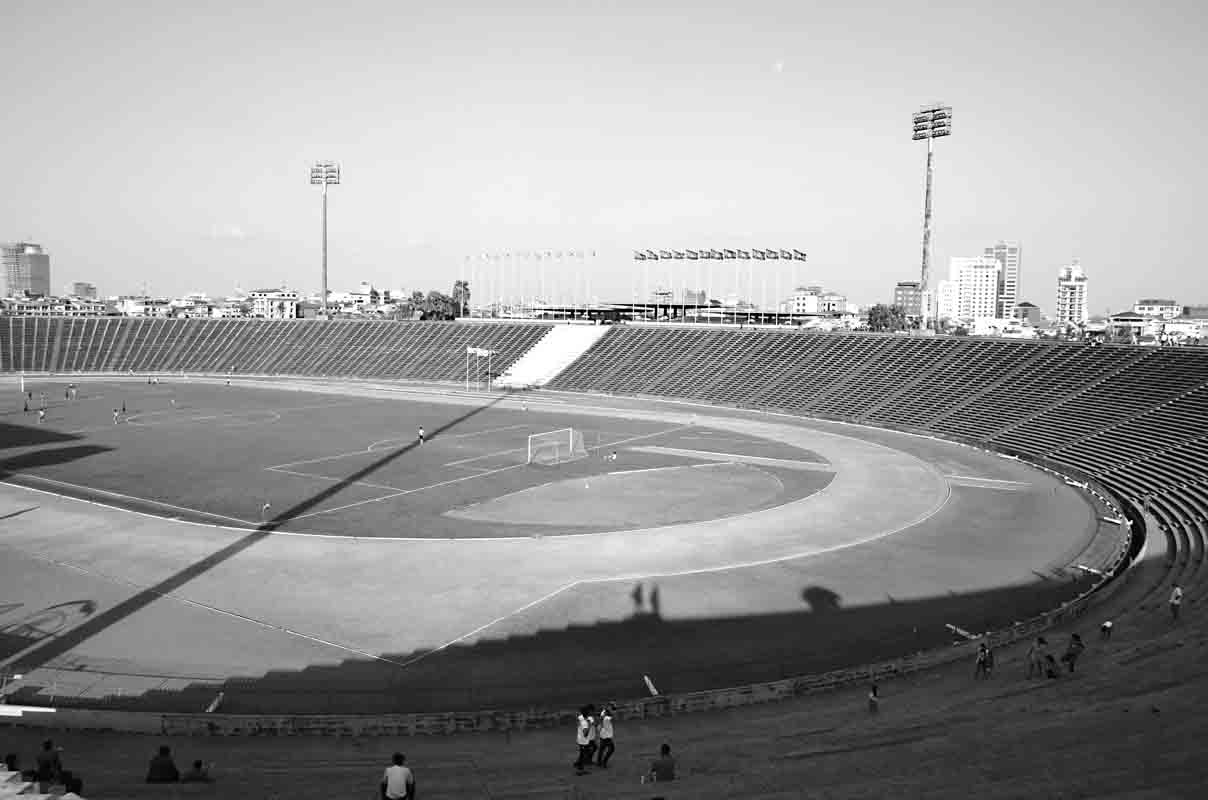It isn’t just Ty and his football team who are concerned about the mooted development of Phnom Penh’s Olympic Stadium. A cathedral to Khmer creativity, the sports complex is a place of pilgrimage for photographers, students, architects and enthusiasts, as well as the myriad joggers, wrestlers and petanquers who make use of its facilities. A perfect marriage of form and function, the structure and its future are as much a matter for sportsmen as they are for urban planners.
Commissioned by Prince Norodom Sihanouk in the salad days of Cambodian independence, the complex was a concrete metaphor for the kingdom’s post-colonial rebirth. At the 1964 opening ceremony, Prince Sihanouk assured his subjects: “We have certainly shown the world that we are not a bastard nation deprived of intelligence, courage and energy, as the enemies of our people and our country have often pretended. Despite the criticism and slander of some of our neighbours and their imperialist masters we have proven our capacity to transform our ancient kingdom into a modern nation.” Stadium architect Vann Molyvann, interviewed by The Wall Street Journal in 2010, remembered that night as “one of the greatest moments of my life”.
Out of this newfound hope and confidence rose New Khmer architecture, a uniquely Cambodian interpretation of architectural modernism, combining slick Le Corbusian esotericism with Khmer guts. Typified by natural lighting and ventilation systems, Angkorian irrigation features, and streamlined vernacular motifs, the style works in harmony with the meteorological extremes of its birthplace. From social housing in Bassac to the (now demolished) Council of Ministers, Sihanouk and Molyvann, the urbane prince and the Sorbonne-educated architect, used New Khmer architecture to transform the city from a sleepy riparian outpost into the modern capital of a country on the ascendant.
But the halcyon days were short. From 1975 to 1979 the outlying sports fields were turned into cabbage patches and Khmer Rouge cadres marched through the arena. The complex fell further into desuetude during the decades of civil strife and occupation; it was only in 2000 that the site was returned to something resembling its former state by a Taiwanese firm, who revivified the stadium on the condition of their entitlement to develop pockets of the periphery for commercial use.
Recently, rumours surfaced claiming that the regeneration was poised to leap from ‘development’ to demolition. While these unconfirmed reports have been energetically refuted by the city Municipality, there’s no denying that the complex is about to undergo a radical make-over, with a cluster of skyscrapers – one 55 storeys high – set to rise up over the low-slung skyline. And despite intentions to protect the stadium, the encroaching development is rumoured to have sorely compromised water run-off, leading to the flooding of surrounding roads and the weakening of the structure’s foundations.
For Dr Dougald O’Reilly, founder of non-profit Heritage Watch International, the rapid reimagining of Phnom Penh’s cityscape has wide-ranging ramifications for inhabitants. “Filling in blank spaces with skyscrapers is ill-advised. The architectural landscape of Cambodia is a testament to the dramatic history of the country stretching over thousands of years. It would be unthinkable to tear down Tuol Sleng and the same should be said of more recently built jewels of Khmer ingenuity. There is a need to develop Phnom Penh, but a crucial part of that development should be an attempt to keep the city liveable and attractive.”
These jewels of Khmer ingenuity are some of the city’s best kept secrets, overwritten by the new face of new Phnom Penh. The architecturally curious are catered for by Khmer
Architecture Tours, who run fortnightly excursions to post-independence buildings such as
Vann Molyvann’s sleek Royal University complex and the stately 1960s villas of Tuol Kork, as well as regular guided walks of Olympic Stadium. The tours provide an opportunity to see the crumbling structures before they sink below the glass and chrome shards of
architectural progress.
As Ty and his teammates kick up and down the Olympic scale football pitch, the echoes of construction bounce off the bleachers. The stadium may have been reprieved for now, but development forges onwards and defiantly upwards on every side.
WHO: Khmer Architecture Tours (ka-tours.org)
WHAT: Guided walks of Olympic Stadium and other architectural gems
WHERE: Around Phnom Penh
WHEN: Fortnightly
WHY: You don’t know what you’ve got ‘til it’s gone
